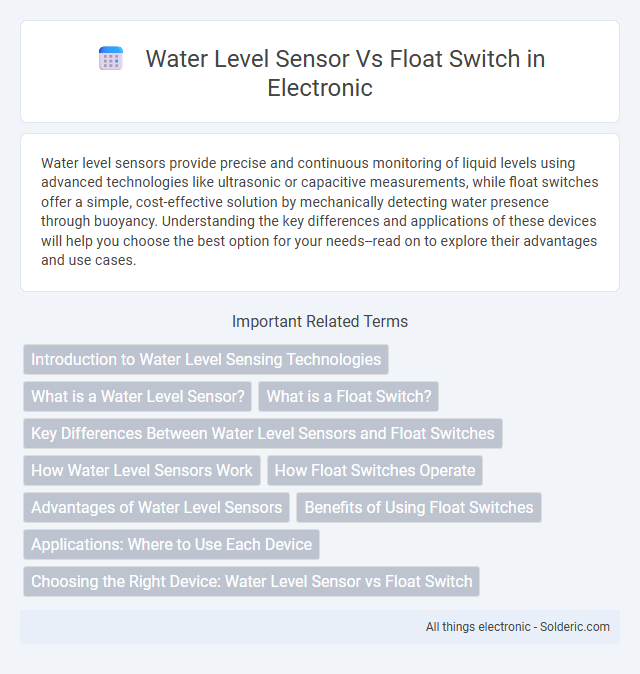Water level sensors provide precise and continuous monitoring of liquid levels using advanced technologies like ultrasonic or capacitive measurements, while float switches offer a simple, cost-effective solution by mechanically detecting water presence through buoyancy. Understanding the key differences and applications of these devices will help you choose the best option for your needs--read on to explore their advantages and use cases.
Comparison Table
| Feature | Water Level Sensor | Float Switch |
|---|---|---|
| Measurement Type | Continuous water level monitoring | Discrete ON/OFF level detection |
| Accuracy | High precision, variable levels | Moderate; triggers at specific point |
| Installation | Complex; requires calibration | Simple; mounted at fixed level |
| Application | Industrial tanks, reservoirs, smart systems | Sump pumps, alarms, basic level control |
| Maintenance | Low to moderate; sensor cleaning needed | Low; fewer moving parts |
| Cost | Relatively higher | Economical |
| Output Signal | Analog or digital signals | Simple switch contact (open/close) |
| Durability | Depends on sensor type; generally robust | Highly durable; mechanical simplicity |
Introduction to Water Level Sensing Technologies
Water level sensors and float switches are essential components in monitoring and controlling fluid levels across various industries. Water level sensors use advanced technologies such as ultrasonic, capacitive, or pressure-based measurements to provide accurate and continuous level data, while float switches rely on mechanical movement to trigger simple on/off signals. Understanding the differences between these technologies helps you select the most suitable solution for precise water level monitoring and automation needs.
What is a Water Level Sensor?
A Water Level Sensor is an electronic device designed to detect the level of water in a tank or container accurately. Unlike a float switch that uses a mechanical float to trigger actions at specific water heights, a water level sensor provides continuous, real-time data using technologies like ultrasonic, capacitive, or pressure-based sensing. Your system benefits from enhanced precision and automated monitoring by integrating a water level sensor.
What is a Float Switch?
A float switch is a type of water level sensor designed to detect the presence or absence of liquid within a container by using a buoyant device that rises or falls with the water. Unlike electronic water level sensors, float switches provide a mechanical solution for triggering pumps or alarms when a specific water level is reached. Your choice between a float switch and other water level sensors depends on the required precision, durability, and application environment.
Key Differences Between Water Level Sensors and Float Switches
Water level sensors provide precise, continuous measurement of liquid levels using technologies like ultrasonic, capacitive, or pressure sensing, whereas float switches operate as simple binary devices that detect high or low liquid thresholds by physical movement. Water level sensors offer real-time data essential for automation and monitoring systems, while float switches are cost-effective solutions for basic on/off control in tanks and reservoirs. The choice depends on application requirements, with water level sensors favored for accuracy and integration, and float switches preferred for simplicity and reliability.
How Water Level Sensors Work
Water level sensors detect liquid levels using technologies such as ultrasonic, capacitive, or pressure-based measurement, converting physical water height into electrical signals. Unlike float switches that rely on mechanical movement of a buoyant component, water level sensors provide continuous, precise monitoring without physical contact. This allows for real-time data integration and improved accuracy in industrial, environmental, and residential applications.
How Float Switches Operate
Float switches operate by using a buoyant component that rises and falls with the water level, triggering an internal switch to open or close an electrical circuit. These devices are commonly employed for controlling pumps, alarms, or valves in tanks and reservoirs. Understanding how float switches work can help you choose the right water level sensor for accurate and reliable liquid level monitoring.
Advantages of Water Level Sensors
Water level sensors provide continuous and precise measurement of liquid levels, enabling accurate monitoring in real-time compared to the binary on/off signals of float switches. These sensors offer enhanced reliability and durability in harsh environments due to their solid-state design, reducing maintenance requirements. Advanced water level sensors integrate seamlessly with automated control systems, improving operational efficiency and safety in applications like water treatment, industrial processes, and environmental monitoring.
Benefits of Using Float Switches
Float switches offer reliable and cost-effective water level detection by mechanically activating alarms or pumps when predefined levels are reached. Their simple design ensures low maintenance, durability in harsh environments, and easy integration into various water management systems. Compared to water level sensors, float switches provide straightforward installation and operation without needing complex calibration or power sources.
Applications: Where to Use Each Device
Water level sensors provide precise real-time measurements ideal for industrial processes, water treatment plants, and automated irrigation systems requiring continuous monitoring. Float switches are simple, cost-effective solutions commonly used in sump pumps, water tanks, and bilge pumps to trigger on/off alerts based on specific water levels. Choosing the right device depends on your application's need for accuracy versus simplicity and budget constraints.
Choosing the Right Device: Water Level Sensor vs Float Switch
Choosing the right device between a water level sensor and a float switch depends on your application's precision and complexity requirements. Water level sensors offer continuous, accurate liquid measurement with digital integration, ideal for automated systems, while float switches provide a simpler, cost-effective solution for detecting specific water levels through mechanical on/off signals. Assessing factors like budget, installation environment, and control needs ensures your system performs reliably and efficiently.
Water level sensor vs float switch Infographic

 solderic.com
solderic.com